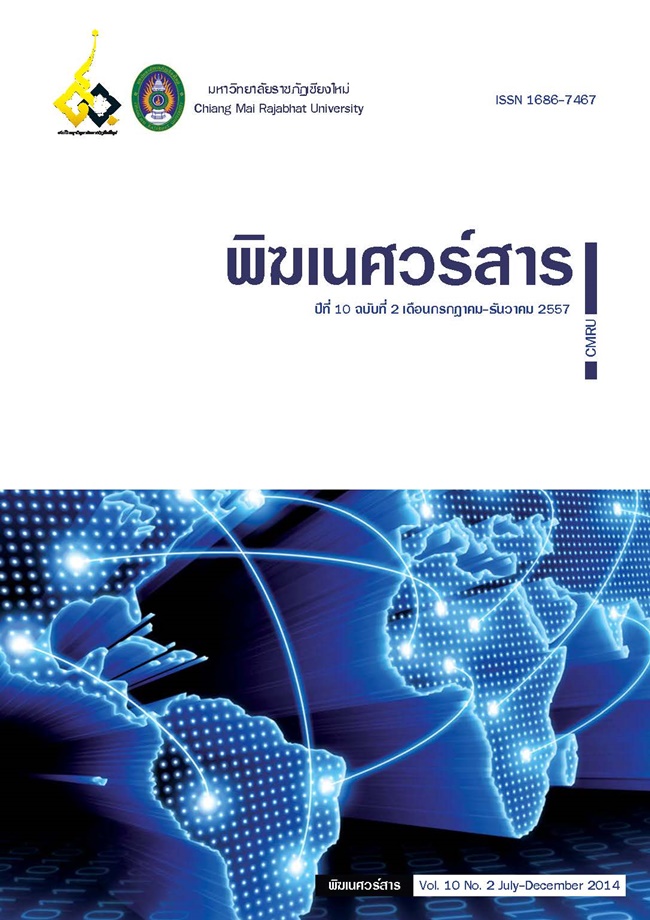ความหลากหลายของสาหร่ายขนาดใหญ่ แพลงก์ตอนพืช แพลงก์ตอนสัตว์ และไดอะตอมพื้นท้องน้ำ และการใช้เป็นดัชนีบ่งชี้คุณภาพน้ำในแม่น้ำลี้ จังหวัดลำพูน
Main Article Content
Abstract
การบ่งชี้คุณภาพน้ำในแม่น้ำลี้ จังหวัดลำพูน โดยใช้สาหร่ายขนาดใหญ่ แพลงก์ตอนพืชแพลงก์ตอนสัตว์ และไดอะตอมพื้นท้องน้ำ ระหว่างเดือนสิงหาคม 2553 – กรกฏาคม 2554 ร่วมกับ การใช้ปัจจัยทางกายภาพและเคมีบางประการจากจุดเก็บตัวอย่าง 4 จุด เก็บตัวอย่าง 4 ครั้ง ครอบคลุม 3 ฤดูกาล โดยทำการสำรวจกลุ่มสิ่งมีชีวิตและความสัมพันธ์กับคุณภาพน้ำรวมถึงลักษณะพื้นท้องน้ำ พบสาหร่าย Division Chlorophyta และ Cyanophyta เป็นชนิดเด่น พบแพลงก์ตอนพืชที่เป็นกลุ่มเด่นคือใน Division Euglenophyta และ Chlorophyta พบแพลงก์ตอนสัตว์ ใน Phylum Protozoa, Rotifera และ Crustacea เป็นชนิดเด่น และพบไดอะตอมจีนัสเด่นได้แก่ Achnanthes spp., Cymbella spp., Gomphonema spp. และ Navicula spp. ตามลำดับ การศึกษาลักษณะทางกายภาพและทางชีวภาพของแม่น้ำลี้ พบว่าบางจุดเก็บตัวอย่างมีการเปลี่ยนแปลง เช่น การขุดลอกดิน ปรับตลิ่ง และ จากการศึกษาดัชนีทางชีวภาพทั้ง 4 ประเภท จะเห็นได้ว่าเป็นสิ่งมีชีวิตที่ดำรงชีวิตในน้ำที่มีสารอาหารปานกลาง จึงอาจประเมินได้ว่าแม่น้ำลี้มีสารอาหารปานกลางและมีคุณภาพน้ำปานกลาง
DIVERSITY OF MACRO ALGAE, PHYTOPLANKTON, ZOOPLANKTON AND BENTHIC DIATOMS AND UTILIZATION WATER QUALITY BIOINDICATORS IN LI RIVER, LAMPHUN PROVINCE
The purpose of this study was to identify the water quality in Li River in Lamphun Province by using Macroalgae, Phytoplankton, Zooplankton and Benthic Diatoms. The study was carried out from August 2010 to July 2011. The study chemical and physical parameters to determine the water quality was the diversity and 4 sampling site were collected once a season. The method was conducted by organisms distribution and their relationship with the environment and substratum. Division Chlorophyta and Cyanophyta were the dominant groups of Macroalgae. Division Euglenophyta and Chlorophyta were the dominant groups of Phytoplankton. Phylum Protozoa, Rotifera and Crustacea were the dominant groups of Zooplankton and Achnanthes, Cymbella, Gomphonema and Navicula were the dominant group of Benthic Diatoms. The organism’s distribution revealed the relationship with a moderate nutrient content According to this study of the physical and biological characteristics of the Li River, it can be concluded that the Li River is of moderate water quality and moderate to moderate nutrient.
Downloads
Article Details
The articles published are copyrighted by the Graduate School, Chiang Mai Rajabhat University.
The opinions expressed in each article of this academic journal are solely those of the individual authors and do not reflect the views of Chiang Mai Rajabhat University or its faculty members. The responsibility for the content of each article rests entirely with the respective authors. In the event of any errors, the authors alone are responsible for their own articles.


